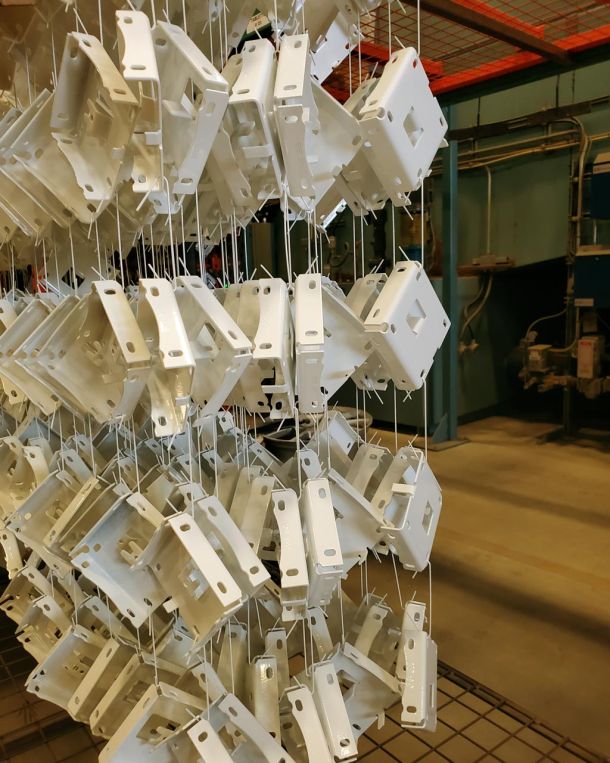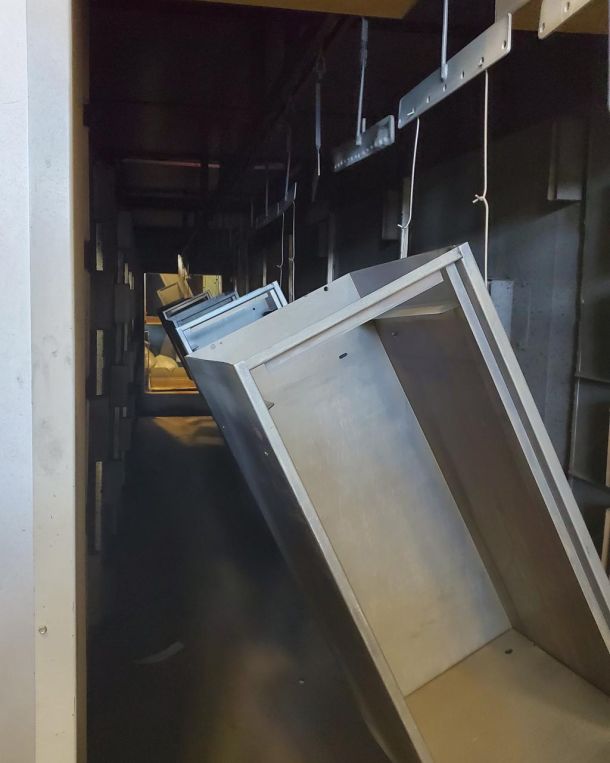Electrostatic paint process
Powder coated paint
Powder-coated paint: treatment process intended to protect metallic surfaces in steel, stainless steel, aluminum or galvanized. Powder coating is also called electrostatic spraying or electrostatic powdering. This powder coating process is mainly used in the metal industry. The goal is to coat ferrous or non-ferrous metals. They are thus effectively preserved from external aggressions.
The paint is in the form of a thermoplastic or thermosetting powder resin. This very fine material then charges positively in an electric field. The paint is then projected using an electrostatic gun. The application tool then carries a positive charge. On the contrary, the conductive part to be painted carries a negative opposite charge.
The powder-coated paint thus temporarily adheres to the part. Then the element is passed into the oven for melting. After, the polymerization of the powder makes the film thermosetting. Indeed, this technique is very suitable for parts with complex shapes or large volumes. Indeed, this process is commonly used in the automotive sector, industry, metal or metal furniture.
Several types of resins exist to formulate a powder coated paint. Polyester resin is therefore used mainly for architectural works. In fact, it is found in buildings, street furniture or outdoor structures. Epoxy resin is more suitable for indoor use. Indeed, it adapts particularly well to the layout of stores. As for it, acrylic resin finds more use in the automobile industry or industrial bodywork for example.
Electrostatic painting
Electrostatic painting: painting process using a specific spray gun charged with static electricity. This technique is also called electromagnetic painting. First, we always start by positively charging the metal part to be painted. Then, we continue by negatively charging the paint that we are going to apply. Ultimately, the objective is to obtain two opposing currents in opposite directions.
The negative particles of the paint are then propelled using a gun. The positively charged metal thus automatically attracts them like a magnet. For this reason, electrostatic painting has many advantages. It reduces the amount of paint in the air that can deposit on adjacent surfaces. It also eliminates mist in the paint booths.
Electrostatic paint remains a reliable way to quickly cover a metal surface. It allows you to paint very complex shapes. Indeed, a traditional method by brush, brush, roller or spray does not provide the same result. In addition, this process allows much faster drying. It also offers a particularly uniform finish for excellent stretch after drying.
Electromagnetic paint is designed to be easily steered. Indeed, the metallic element to be painted literally attracts the coating. It avoids drips, marks and unsightly marks. This just uses the amount of paint needed for the room. Painting a hard-to-reach surface is much easier. We no longer dirty everything around.
Protech-Oxyplast Powder Coatings
The Protech-Oxyplast Group continues to expand its product lines as it relentlessly strives to provide the service that its customers have grown to expect. Our activities are not just limited to thermoset powder coatings.
Protech-Oxyplast is proud to announce that through our recent acquisitions of Innotek and Thermoclad, we are now able to offer a full range of thermoplastic powder coatings. These product additions make the Protech-Oxyplast Group unique among global powder coating producers in terms of the breadth of powder technologies offered.
TIGER Drylac® Powder Coating
Powder coatings are solvent-free enamels manufactured using a 3-step process. The powder coating is applied to the part or component by electrostatic spraying equipment or in a tribostatic process. In a subsequent curing process, the powder coating is melted and chemically cross-linked at substrate temperatures of 150 to 200°C (302 to 392°F).
The success story of powder coating begins with industrial surface finishing in the 1960s and continues to develop as the technology has many advantages:
- No solvents
- Virtually 100% material utilization
- Easy to process and clean
- Applicable on many substrates
- Protective and decorative
TIGER Drylac® offers the most comprehensive standard range of colours and effects.
Powder coatings production
TIGER Drylac® powder coatings are solvent-free coating materials consisting of different synthetic resin systems, pigments and special additives for high-quality surface finishing. The basic materials for powder coatings are processed into a fine coating powder in a 3-step production process: premixing, extrusion and milling. Depending on subsequent use, the powder is set to a predefined particle distribution.
In contrast to liquid paints, powder coatings do not contain solvents. Powder coatings are applied to parts by electrostatic spraying equipment or in a tribostatic process. In a subsequent curing process, they are melted and chemically cross-linked at substrate temperatures of 150 to 200°C (302 to 392°F).



